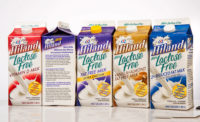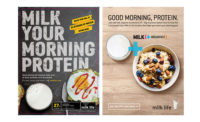These are tough times for dairy brands. Sales of dairy products have dropped considerably and are decreasing further every year. Health-conscious consumers are searching for alternatives to milk and dairy, increasingly turning to options such as soy milk, almond milk, water and juices. Schools have greatly limited the prevalence of full-fat milk in an attempt to battle the epidemic of childhood obesity.
None of this is positive news for the dairy industry. In times like these, dairies are anxiously hunting for any advantage they can secure in the marketplace, and dairies are desperately trying to find ways to raise their bottom line. There’s a way out of this mess, however, and it’s simpler than you might think.
In the face of new Food and Drug Administration labeling regulations set to be finalized soon, dairies are about to be forced to add a considerable amount of nutritional information to their labeling. While these regulations may appear to be just another hurdle for the industry, these new mandates actually present a unique opportunity to dairies to utilize the most time-tested, industry-proven way to refresh a brand and significantly increase sales — a complete revamp of product packaging.
Considering that dairy companies will already have to redesign their labeling when the new FDA regulations go into effect, there has never been a better time to strategically overhaul dairy packaging. With regulatory change imminent, dairies must re-evaluate their brand and ensure that their packaging communicates a modern, healthy and competitive image.
Back to basics
Over the past decades, dairy manufacturers have relied on the public’s perception of milk as a healthy and necessary part of the diet to drive sales. Now, with public perception making a significant shift away from this train of thought, it’s essential that the dairy industry goes back to basics and focuses on what truly drives sales. Whichever way you cut it, the key driver of any dairy brand is its packaging. Nothing represents a more direct connection to customers. It’s your brand’s way of directly communicating with the consumer as they try to decide if they’ll go with you or with your competitors.
When consumers first notice a package redesign, it sends a strong message that the dairy product is improved with new ingredients and increased health benefits. Wencel Design has tested numerous redesigns for dairy companies and has proven that sales consistently increase 10% to 20% when packaging is refreshed. Consumers are inherently attracted to fresh design and want to find out what’s new or what’s going on with that redesigned product. A design revamp is less expensive than a national advertising campaign, but has a similar effect by bringing your brand a larger presence in the marketplace.
Designing your packaging
To formulate an ideal template for your package redesign, it’s important to examine and learn from the methods to which the industry has historically chosen to adhere. Some historical staples of dairy packaging, specifically milk packaging, have been:
- A large brand name/product name
- An FDA qualifier at half the size of the product name
- No added-value consumer information
- No usage of side panel
- In most cases, no reference to the history of the dairy, such as information about the founders
- In most cases, little information regarding the health benefits of that specific product
While these methods worked in the past, the consumer base and industry itself has evolved, and leaving out such information simply will not suffice any longer. There is a lot to learn from traditional packaging techniques, but there is also a lot of progress to be made. When putting together a package design, it’s still important to prioritize your content. Brand is No. 1, product name is No. 2 and appetite appeal is No. 3.
With consumers more health-conscious than ever, it’s just as important to highlight health benefits and promote the product’s nutritional value to distinguish your brand from your competitors. Wencel Design will designate a clean and impactful principal “display panel” on one side of your packaging to send a clear message to consumers that your product will positively influence their family’s health. Studies have proven that milk efficiently delivers protein, calcium and essential vitamins and minerals. Dairy products also have a remarkably positive effect on preserving bone integrity and preventing muscle loss, particularly for aging adults.
A health-conscious market
Current research shows that there is about $4.6 billion in revenue to be made in the health and wellness sector. Research also demonstrates that products in this sector have a good chance at success, as long as they educate consumers on the benefits of their products.
Claims involving protein, calcium and vitamins should be large and placed on the principle display panel of all branded dairy packaging. Times have changed, and these claims are no longer secondary and non-essential. They are now often the primary factor that causes a consumer to choose your brand over your competitor’s. There are plenty of resources available to dairies to provide marketable information about the health benefits of dairy products, these resources simply need to be tapped into. The dairy associations of today are more high-tech than ever and can give dairies the innovative edge required at the point of sale to increase sales to where they were a few decades ago.
Research and innovation are key
Package design is often thought to be a task solely for designers and artists, but in reality, the direction of packaging design is a process in which all of the most important members of an organization must be involved. After all, packaging is the brand’s single strongest connection to the consumer; the endpoint of a dairy’s marketing strategy. The dairy industry has a fairly poor track record of being attentive to market research or consumer comments regarding the design of their packaging. Considering how vital effective packaging is, dairies need to focus more on exploring trends in the marketplace and examining consumer behavior to develop the most powerful dairy packaging possible.
Wencel Design looks into the dairy market from the outside to determine what consumers are truly looking for and which packaging strategy will directly translate into improved sales. There is a highly rational, scientific approach behind the graphic design and execution of the best product packaging, and not all dairies possess the internal knowledge to employ this approach. Branding is closely tied to reputation, and in the dairy industry, reputation is everything. Your packaging should reflect that viewpoint. Don’t be afraid to seek outside help when your dairy decides to redesign. The experience and knowledge of career dairy package designers is essential to the production of valuable packaging and crucial to protecting your brand’s reputation.
Additionally, dairies need to work more closely with packaging container supply companies to improve their packaging. In the last 40 years, there has not been a great deal of innovation on the container/supply side of the packaging equation. For instance, perhaps the largest design change for the traditional milk carton is the addition of a simple plastic screw-top cap. These changes seem small and inconsequential when compared to other industries, which have grown quite creative with their container design.
Finally, do not wait to redesign until the FDA makes its final regulatory changes on ingredients and packaging requirements. As the old saying goes, “If you snooze, you lose.” Dairies are losing their value quickly, sales are dropping and the competition is growing increasingly aggressive.
Dairy branding needs to be updated to adapt to a rapidly changing consumer base and quickly evolving trends of the marketplace. To squash its competitors in the growing milk alternative sector, dairies need to offer the same new, exciting feeling that consumers get from those alternatives. The idea that package design can last for eight to 10 years is swiftly becoming history. Some smaller dairy brands redesign new packaging every four to five years to keep pace with the market.
Give your consumers new images and current information on all branded packaging every time you redesign, and help put innovation and excitement back in dairy’s DNA.









